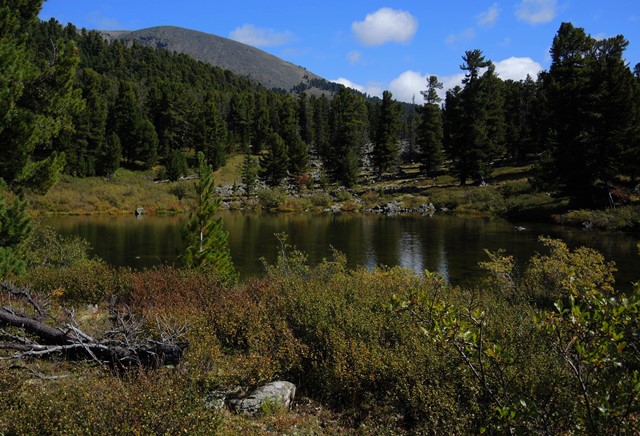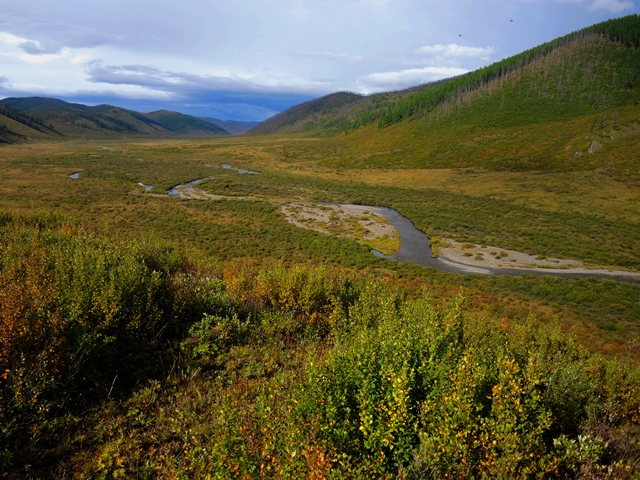No products in the cart.
Horseback Expeditions to Exlore Historic Sites in the Khentii Mountains of Mongolia
The Khan Khentii – the largest Wilderness Area in Mongolia

The Khentii mountains of Mongolia reach close to the capital city Ulaanbaatar with their westernmost ranges, yet their backcountry makes the most remote and inaccessible wilderness in the country. Wild rivers, bogs, dense forests and rugged mountains still protect the interior of the Khentii from vehicle traffic and larger numbers of visitors, though transgressions with tracked and all terrain vehicles with damaging ecological impacts do occur and are likely to increase unless effective measures are taken. The Khentii wilderness is the largest road less area in Mongolia. Designated as a Special Protected Area (SPA), it enjoys the highest formal protection status in Mongolia’s system of protected areas. With about 4635 square miles (2.9 Million acres, 1.2 Mio hectares) of wild lands, the Khan Khentii is nearly 1200 square miles (or 700.000 acres, 300.000 hectares) larger than Yellowstone.
Khentii – Homeland of Chinggis Khaan
The Khan Khentii is best visited on horseback, both for the protection of its fragile environment and to make for a better visitor’s experience through an eco-tour on horseback. This wilderness has a system of ancient trails, along water courses and over mountain passes that have been in use for centuries, and it is likely that no lesser than Chinggis Khaan himself rode these trails, having spent his youth as Temujiin in the Eastern part of what is now Khentii Province (Aimag) in Mongolia, and later as a warrior fighting and uniting the tribes in the region. It is from here that he set out to establish the largest empire in human history.
The Khentii province and the Khan Khentii Special Protected Area hold numerous sites referred to in the “Secret History of the Mongols” that are significant to the life of the historic Mongolian leader. These include the Onon River of the years of his youth, the Tuul River, the “Blue Lake”, where he was declared Chinggis Khaan, and Burkhan Khaldun, the mountain he is thought to have visited repeatedly to seek spiritual strength on the windswept summit. Today, the mountain is among the most sacred peaks in the country. Chinggis Khaan’s burial site is also in the Khentii though its exact location is not known.
Protection of the Khentii Wilderness in Mongolia

When Mongolia was a close ally of and dominated by the Soviet Union for seven decades that ended in 1990, religious practice was suppressed, and so was the identification with the history of Mongolia as a powerful independent country and its own ancient traditions. As the Khentii area was holding the sites so closely linked to Chinggis Khan and the national identify of the country, access to the area was restricted for decades so as not to encourage worship and the cherishing of traditions.
While conservation of the natural environment may not have been the primary motivation to protect the Khentii in this period, the strictly regulated access helped set aside a wilderness area of great importance. The Siberian Taiga forest landscapes are habitat for moose, elk, roe deer, musk deer, wolf, lynx, bear and wolverine. While wildlife populations have been decimated in recent decades, the habitat that is still largely pristine offers opportunity for species recovery.
Khentii – Important Water Resources under a Changing Climate

The wilderness landscape also entails the watersheds for several river systems that are the lifeblood for urban and rural water supply in Mongolia. The Khentii mountain ranges are a great divide, with the Onon and Kherlen Rivers draining Eastward and to the Pacific Ocean, while the waters of the Tuul River ultimately flow into the Arctic Ocean. The Tuul River provides the drinking water supply for Ulaanbaatar City, now home to about half the population of the country.
Climate change is impacting Mongolia with increased temperature averages and drought frequency, higher climate variability and more extreme weather events. Securing water supplies and protecting watersheds is therefore a priority for sustainable development in Mongolia, and the Khentii region plays an important role in providing crucial ecosystem services that the capital city of this fast changing country depends on.
Ecotourism on Horseback to Explore Buddhist sites and Burial Temples in the Khentii Mountains
While much of the historic sites of the Khentii date back to the life of Chinggis Khan in the 13th century, there are also very significant relics that stem from the 17th century. Horseback riding eco-tours with Stone Horse Expeditions explore these areas on an 8 day ride in the cultural landscapes of Gorkhi Terelj National Park and on a 12 day deep wilderness riding adventure into the Khentii. The relics of the 17th century are those of Buddhist monasteries, one of them built as the new center of the Gelug tradition of Buddhism in Mongolia.
Khentii Wilderness – Center of Mongolian Buddhism in the 17th Century

The forest trail high in the mountain wilderness north of the Upper Tuul valley today conveys an image of true wilderness. When our horse trek on the Khentii Mountains expedition makes its way to a pass with picturesque alpine lakes where old pine trees rise against a back drop of high scree slopes and a blue sky we are in deep, remote wilderness. Yet, we are passing a site where once the 16th reincarnation of the Buddha resided and maintained a center of studies, arts and religion.
Saridkhiin Khid, a monastery complex with 17 large temples, three big stupas and several service buildings, was built on the lower slope of Khiidiin Saridgiin Uul (Mountain) where the natural lay of the land forms a terrace at about 6000 feet. This important center was established by Zanabazar, the Mongolian religious leader who had studied in Tibet with the Panchen Lama, and introduced the Gelug sect of Buddhism in his country. In 1654, he chose this remote site and began constructions; much of the design was influenced by the Tibetan monks and artisans traveling with him.
Originally named “Ribo-Gejai-Gandan-Shadublin”, the center of which the largest building was a 108 pillar temple, became better known as “Saridkhiin Khid” or was referred to as “Ikh Khuree” like other residences of the religious leader. Zanabazar (1635-1723), a distant descendent of Chinggis Khaan, was the first Bogd Gegen (The First Resplendent Saint) of Mongolia; at the age of five, he was recognized by the Panchen Lama and Dalai Lama as a Living Buddha. He is considered to have been the 16th reincarnation of the Buddha. (Croner, D. 2006)
Gunjiin Sum – the Burial Temple for “The Peaceful Princess” in Gorkhi Terelj National Park

On our 8 day rode in Gorkhi Terelj National Park we explore another historic site. It is within easier reach, yet it is also hidden deep in Taiga forest and nestled at the foot of high mountains. Our expedition often stops for a night or two at a picturesque ger camp from where we reach Gunjiin Soum on a loop ride that takes our small group of riders through a landscape of mixed forest steppe. This ride offers great trails to trot on, and open country for some exhilarating cantering and a bit of a gallop for the riders and horses who feel like it. The trail eventually leads to an opening in the forest, the site of the “Princess Temple” (Gunjiin Sum). The temple is dedicated to a Mongolian nobleman’s Manchu wife who became known as “The Peaceful Princess” and for loving her adopted country and its people. [1]
The story of the princess is linked to Zanabazar as well. Dondovdorj, to whom the princess was married, was the son of Zanabazar’s nephew Galdandorj. After Zanabazar had recognized Manchu suzerainty, the Quing emperor bestowed a title of prince upon Galdandorj, and his son Dondovdorj was brought up in the Quing court. In 1697 the Quing emperor gave the princess to Dondovdorj for marriage. Her name was Khichenguy Amarlinguy, – she was the first of three wives of Dondovdorj, and she moved to Mongolia with her husband. According to legend she wished to be buried in Mongolia, as she considered herself to be Mongolian, and the Quing emperor at the time of her death around 1740 ordered a burial temple to be built for her.
Temple Ruins deep in the Taiga Forest of Gorkhi Terelj National Park, Mongolia

The temple complex consisted of a stele tower, entrance, guard house and the tomb of the princess. The compound was heavily damaged in the purges of the 1930ies. The tower at the entrance has been restored, with a stone turtle and stele inside. Inscriptions in Chinese and Manchurian dedicate the temple to “The Peaceful Princess”. The walls of the temple remains have also been restored to some extend. A brick wall surrounding the compound is the most intact feature of the temple site. The tomb was looted in the early 1930ies. Today, visitors can see the brick construction of the tomb as it has remained unearthed. In 1949 researchers found remnants of a sandalwood coffin and ashes of her body apparently burnt by the looters; her ashes have been scattered to the winds. (Croner, D. 2006).
Book Your Horse Riding Tour with Stone Horse in the Khentii Mountains and in Gorkhi Terelj National Park, Mongolia.
Watch the 2013 Ecotourism Riding Adventures with Stone Horse Expeditions in Mongolia’s Khan Khentii and Gorkhi Terelj National Park. See clips of 2014 Horse Treks in Mongolia with Stone Horse.
 Sabine Schmidt is a co-owner at Stone Horse Expeditions & Travel. She rides and guides with her husband Keith Swenson, who founded the outfit that specializes in high quality, low impact horseback eco-tours in Mongolia. Sabine also builds “Stone Horse Saddles”- lightweight and robust Western style saddles appreciated by guests, the horses, and the Stone Horse team for their beauty and comfort.
Sabine Schmidt is a co-owner at Stone Horse Expeditions & Travel. She rides and guides with her husband Keith Swenson, who founded the outfit that specializes in high quality, low impact horseback eco-tours in Mongolia. Sabine also builds “Stone Horse Saddles”- lightweight and robust Western style saddles appreciated by guests, the horses, and the Stone Horse team for their beauty and comfort.
Further Reading on historic sites of the Khentii, on Zanabazar and Buddhism in Mongolia:
http://www.tibetan-museum-society.org/
Croner, D. 2006: Illustrated Guidebook to Locales Connected with the Life of Zanabazar: First Bogd Gegeen Of Mongolia. Solar Star Press
[1] Croner, D. 2006: Illustrated Guidebook to Locales Connected with the Life of Zanabazar: First Bogd Gegeen Of Mongolia. Solar Star Press


